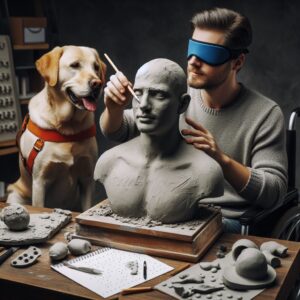Table Of Contents
- 1 Exploring Artistic Expression: Introduction to Clay Sculpting for People with Low Vision
- 2 Why Clay Sculpting for People with Low Vision?
- 2.1 Deciphering the Meaning: Exploring the Specifics of Clay Sculpting for People with Low Vision
- 2.2 Understanding the Challenges:
- 2.3 Empowering Adaptations:
- 2.4 Shaping Possibilities: Practical Techniques and Resources for Clay Sculpting with Low Vision
- 2.5 Techniques:
- 2.6 Tools and Resources:
- 2.7 Conclusion
- 2.8 Key Takeaways:
- 2.9 Frequently Asked Questions:
- 2.9.1 1. What types of clay are best for individuals with low vision?
- 2.9.2 2. What adaptations can be made for individuals with limited dexterity?
- 2.9.3 3. How can I find clay sculpting resources for individuals with low vision?
- 2.9.4 4. What are some tips for encouraging creativity in individuals with low vision?
- 2.9.5 5. How can I ensure a safe and inclusive clay sculpting environment?
Exploring Artistic Expression: Introduction to Clay Sculpting for People with Low Vision

Clay sculpting, an art form deeply rooted in tactile exploration and sensory experience, holds immense potential for individuals with low vision. While visual perception may be limited, the hands become instruments of discovery, shaping emotions, memories, and imagination into tangible form. This session delves into a comprehensive introduction to clay sculpting for individuals with low vision, highlighting its unique benefits and offering an overview of this rewarding artistic pursuit.
Why Clay Sculpting for People with Low Vision?
Clay sculpting offers a multitude of benefits for individuals with low vision, empowering them to:
- Explore tactile sensation: The act of manipulating clay provides rich sensory input, engaging the sense of touch and promoting tactile awareness.
- Boost creativity and self-expression: Clay sculpting allows individuals to express their emotions, ideas, and memories through a tangible medium, fostering creativity and self-discovery.
- Enhance fine motor skills: Kneading, shaping, and manipulating clay strengthens hand muscles and improves dexterity, coordination, and fine motor skills.
- Promote cognitive function: Clay sculpting engages various cognitive processes, such as planning, problem-solving, and spatial reasoning, leading to cognitive improvement.
- Reduce stress and anxiety: The meditative and repetitive nature of clay sculpting can be calming and therapeutic, promoting relaxation and stress reduction.
- Build social connections: Sharing clay sculpting activities with others can foster social interaction, communication, and collaboration, leading to a sense of community and belonging.
Beyond these specific benefits, clay sculpting offers a unique opportunity for individuals with low vision to connect with the artistic world, explore their creativity, and express themselves in a meaningful and fulfilling way.
In the next, we’ll delve deeper into the meaning of “clay sculpting for people with low vision,” exploring the specific challenges and adaptations that make this art form accessible and inclusive.
Deciphering the Meaning: Exploring the Specifics of Clay Sculpting for People with Low Vision

As we continue our exploration of clay sculpting for people with low vision, let’s delve into the specific meaning of this term, examining the challenges and adaptations that make this artistic pursuit accessible and inclusive.
Understanding the Challenges:
Individuals with low vision face various challenges when engaging in clay sculpting, including:
- Limited visual feedback: Difficulty in perceiving details, shapes, and dimensions of the clay can hinder sculpting accuracy and progress.
- Difficulty with fine motor control: Weakened hand muscles or reduced dexterity can pose challenges in manipulating and shaping the clay.
- Accessibility of tools and materials: Identifying tools with appropriate textures and sizes, as well as choosing contrasting clay colors for increased visibility, can be difficult.
- Navigating unfamiliar environments: Unfamiliarity with a new sculpting space or lack of proper lighting can lead to difficulties in accessing materials and navigating the workspace safely.
Empowering Adaptations:

Fortunately, a range of adaptations can be implemented to overcome these challenges and ensure a fulfilling clay sculpting experience for individuals with low vision:
- Tactile markers and textures: Using textured rolling pins, textured stamps, and embossed tools can provide valuable tactile feedback and aid in shaping and creating specific textures.
- High-contrast clay colors: Opting for contrasting clay colors like black and white or bright and dark hues can enhance visibility and make details more discernible.
- Large-handled tools: Utilizing tools with larger handles can provide greater grip and control for individuals with limited fine motor skills.
- Verbal descriptions and guidance: Providing verbal descriptions of shapes, textures, and sizes can assist individuals in visualizing their creations and achieving their desired results.
- Accessible workspaces: Ensuring proper lighting, organizing tools within easy reach, and maintaining a clear and clutter-free workspace can enhance accessibility and safety.
- Partnering with sighted assistants: Collaboration with sighted assistants can provide valuable support with tasks like mixing clay, reading instructions, and providing visual feedback.
By understanding the specific challenges and implementing these adaptations, individuals with low vision can enjoy the therapeutic benefits and creative freedom offered by clay sculpting.
Now next, we’ll embark on a practical exploration of clay sculpting techniques and resources tailored to individuals with low vision.
Shaping Possibilities: Practical Techniques and Resources for Clay Sculpting with Low Vision
Equipped with an understanding of the meaning and challenges of clay sculpting for individuals with low vision, let’s delve into a practical exploration of specific techniques, tools, and resources that can empower them to embark on this creative journey.
Techniques:
- Coil building: This technique involves rolling clay into long coils and joining them to create three-dimensional structures. The tactile nature of the coils and the repetitive process can be easily adapted for individuals with low vision.
- Pinch pots: Using their fingers to pinch small pieces of clay and form simple shapes is a beginner-friendly technique that requires minimal visual input and can be adapted with textured stamps for added detail.
- Slabs: Flattening clay into slabs and cutting or shaping them into different forms promotes tactile exploration and can be adapted with templates or guides for creating specific shapes.
- Texture exploration: Utilizing various textured tools, sponges, and natural materials allows individuals to explore different textures through touch and incorporate them into their creations.
- Molding: Using pre-made molds allows individuals to create complex shapes without relying on visual perception, making it an excellent option for those with limited vision.
Tools and Resources:
- Tactile tools: Tools with textured handles, contrasting colors, and raised markings can provide valuable tactile cues and aid in manipulation.
- Clay extruders: These tools enable individuals to create consistent, even shapes and textures, eliminating the need for precise hand-shaping.
- Textured rolling pins: These tools offer a variety of textures and can be used to create textured patterns on clay surfaces, providing tactile feedback and enhancing visual contrast.
- Magnifying glasses: Utilizing magnifying glasses can assist individuals with low vision in observing details and achieving greater precision in their sculpting.
- Audio instructions and tutorials: Audio recordings of sculpting techniques and tutorials can provide valuable guidance and support for individuals with limited vision.
- Online communities and forums: Connecting with online communities and forums dedicated to clay sculpting can offer support, inspiration, and resources for individuals with low vision.
Remember, the key to successful clay sculpting with low vision lies in focusing on the sense of touch and exploring tactile cues. By utilizing the techniques and resources mentioned above, individuals with low vision can embrace the creative freedom and therapeutic benefits offered by this art form.
Now we’ll summarize key takeaways and discuss frequently asked questions, solidifying your understanding and empowering you to explore the world of clay sculpting with confidence.
Conclusion
As we conclude our exploration of clay sculpting for people with low vision, let’s solidify key takeaways and address frequently asked questions, empowering you to embrace this rewarding creative pursuit.
Key Takeaways:
- Clay sculpting offers a unique and accessible artistic outlet for individuals with low vision, providing therapeutic benefits, fostering creativity, and enhancing sensory awareness.
- Understanding the specific challenges faced by individuals with low vision is crucial for implementing effective adaptations and ensuring an inclusive sculpting experience.
- Various techniques, such as coil building, pinch pots, and slab construction, can be easily adapted for individuals with low vision and promote tactile exploration.
- Utilizing textured tools, magnifying glasses, and audio resources can further enhance accessibility and empower individuals to achieve their creative visions.
- Clay sculpting provides a safe and supportive environment for self-expression, discovery, and fostering of social connections for individuals with low vision.
Frequently Asked Questions:
1. What types of clay are best for individuals with low vision?
Opt for air-dry clays for easier cleanup and handling. Polymer clays offer durability but require baking, which may necessitate assistance. Choose contrasting colors for increased visibility.
2. What adaptations can be made for individuals with limited dexterity?
Large-handled tools, pre-made molds, and textured rolling pins can simplify manipulation. Partnering with sighted assistants can provide additional support.
3. How can I find clay sculpting resources for individuals with low vision?
Online communities, forums, and organizations dedicated to art accessibility offer valuable resources and support. Audio tutorials and instructional videos can also be helpful.
4. What are some tips for encouraging creativity in individuals with low vision?
Provide opportunities for sensory exploration with various textures. Encourage experimentation and playfulness with different techniques and tools. Offer verbal descriptions and prompts to inspire creative ideas.
5. How can I ensure a safe and inclusive clay sculpting environment?
Maintain clear walkways, organize tools within reach, and use adequate lighting. Provide clear instructions and offer assistance when needed. Encourage open communication and respect individual preferences.
By embracing the potential of clay sculpting for people with low vision, we can create a more inclusive and enriching artistic experience for all. Remember, the journey of clay sculpting is a journey of self-discovery, empowerment, and creative expression. So, let your hands guide you, explore the possibilities of clay, and witness the transformative power of this therapeutic art form.
This concludes our exploration of clay sculpting for people with low vision. We encourage you to continue learning and exploring the possibilities of this accessible and rewarding artistic pursuit. Please feel free to leave a comment below if you have any questions.

1 thought on “Unlocking the World of Clay Sculpting For People With Low Vision”